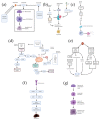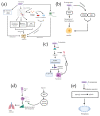Pseudomonas Aeruginosa Induced Cell Death in Acute Lung Injury and Acute Respiratory Distress Syndrome
- PMID: 32731491
- PMCID: PMC7432812
- DOI: 10.3390/ijms21155356
Pseudomonas Aeruginosa Induced Cell Death in Acute Lung Injury and Acute Respiratory Distress Syndrome
Abstract
Pseudomonas aeruginosa is an important opportunistic pathogen responsible for the cause of acute lung injury and acute respiratory distress syndrome. P. aeruginosa isthe leading species isolated from patients with nosocomial infection and is detected in almost all the patients with long term ventilation in critical care units. P. aeruginosa infection is also the leading cause of deleterious chronic lung infections in patients suffering from cystic fibrosis as well as the major reason for morbidity in people with chronic obstructive pulmonary disease. P. aeruginosa infections are linked to diseases with high mortality rates and are challenging for treatment, for which no effective remedies have been developed. Massive lung epithelial cell death is a hallmark of severe acute lung injury and acute respiratory distress syndrome caused by P. aeruginosa infection. Lung epithelial cell death poses serious challenges to air barrier and structural integrity that may lead to edema, cytokine secretion, inflammatory infiltration, and hypoxia. Here we review different types of cell death caused by P. aeruginosa serving as a starting point for the diseases it is responsible for causing. We also review the different mechanisms of cell death and potential therapeutics in countering the serious challenges presented by this deadly bacterium.
Keywords: Pseudomonas aeruginosa; acute lung injury/acute respiratory distress syndrome; apoptosis; cell death; ferroptosis; lung infection.
Conflict of interest statement
The authors declare no conflict of interest.
Figures



References
-
- COVID-19 Map. [(accessed on 6 July 2020)]; Available online: https://coronavirus.jhu.edu/map.html.
-
- Høiby N., Frederiksen B. Cystic Fibrosis. Arnold Publishers-International Book and Journal Publishers; London, UK: 2000. Microbiology of cystic fibrosis; pp. 83–107.
Publication types
MeSH terms
Grants and funding
LinkOut - more resources
Full Text Sources

